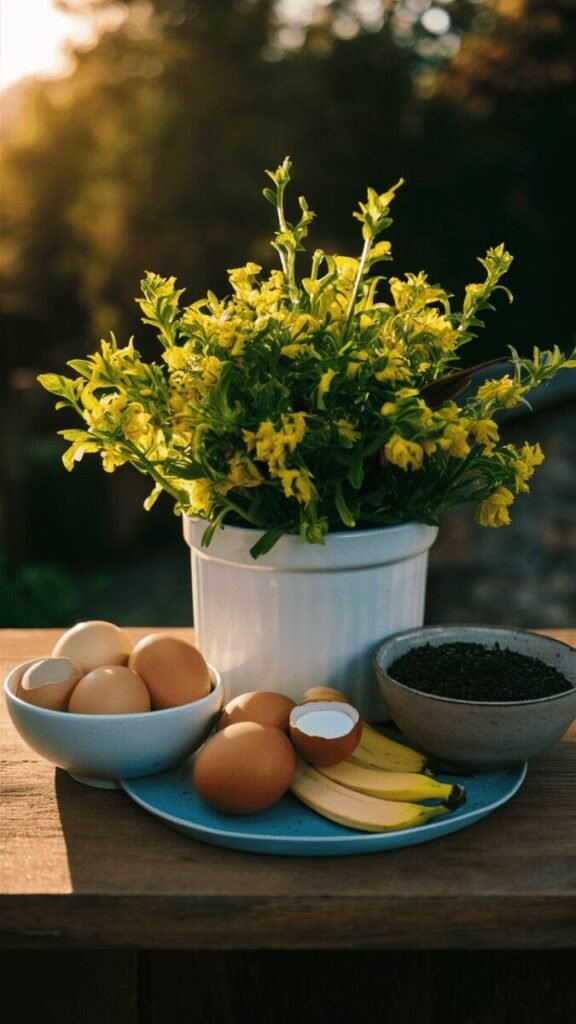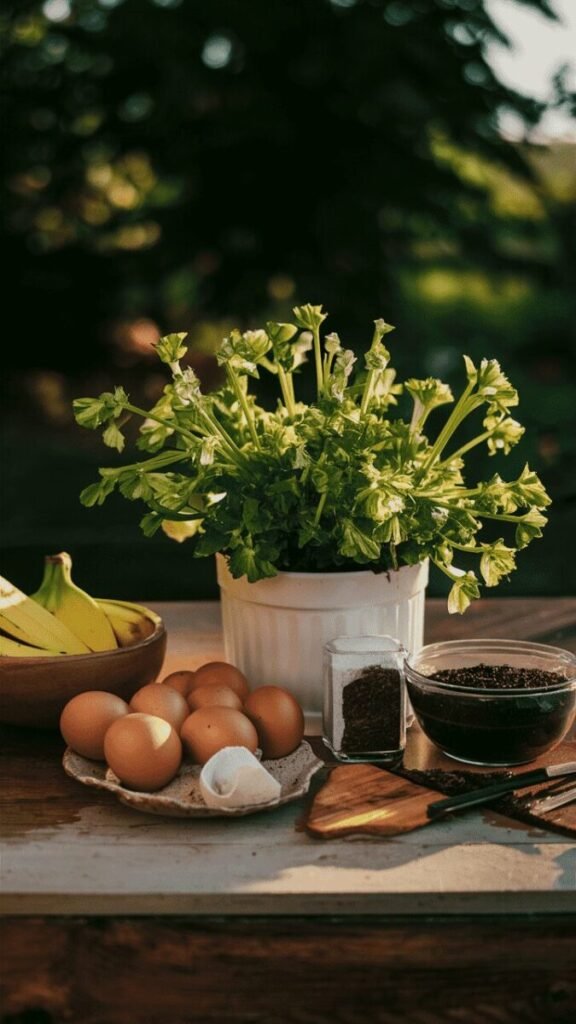As a seasoned pepper with 20 years of survival experience under my belt, I know a thing or two about making the most of limited resources.
When it comes to keeping your survival garden thriving, you don’t need fancy, store-bought fertilizers. Household items you likely have on hand can do the trick just as well, if not better.
Let’s dive into seven surprising household treasures that can nourish your plants and keep your garden fertile and productive.
Table of Contents
Eggshells: A Calcium Powerhouse for Your Plants

Eggshells are an excellent source of calcium, a vital nutrient that promotes strong cell walls and healthy growth in plants. Calcium deficiency can lead to issues like blossom end rot in tomatoes and stunted growth in other vegetables.
Why Eggshells?
- Rich in calcium carbonate, providing an easily absorbable form of calcium
- Gradually release calcium into the soil as they break down
- Help maintain optimal soil pH levels
Preparing Eggshells for Your Garden
- Rinse eggshells and allow them to dry completely.
- Crush or grind the eggshells into a fine powder using a blender, coffee grinder, or by placing them in a resealable bag and rolling over them with a rolling pin.
- Sprinkle the eggshell powder directly into the planting hole or around the base of plants.
Application Tips
| Plant | Recommended Amount |
|---|---|
| Tomatoes | 1 tbsp per plant |
| Peppers | 1 tsp per plant |
| Brassicas (broccoli, cauliflower) | 2 tbsp per square foot |
Coffee Grounds: Giving Your Soil a Caffeinated Boost

Coffee grounds are a fantastic source of nitrogen, phosphorus, and potassium – the three primary nutrients plants need to thrive. They also improve soil texture, water retention, and aeration.
The Benefits of Coffee Grounds
- Provide a slow-release source of essential nutrients
- Help suppress fungal diseases and pests like slugs and snails
- Improve drainage in clay soils and water retention in sandy soils
Acquiring Coffee Grounds
- Save your own grounds from your daily brew
- Ask local coffee shops if they have free grounds available
- Check for coffee ground suppliers in your area
Using Coffee Grounds in Your Garden
- Work 1-2 inches of grounds into the top few inches of soil around plants
- Sprinkle grounds around the base of plants as a top dressing
- Add grounds to your compost bin to introduce beneficial microbes
Banana Peels: The Potassium-Rich Treat Your Plants Crave
Banana peels are an excellent source of potassium, an essential nutrient that supports overall plant health, water regulation, and disease resistance. They also contain smaller amounts of phosphorus, calcium, and magnesium.
Potassium and Plant Health
- Promotes strong stem growth and root development
- Enhances flower and fruit production
- Boosts drought tolerance and disease resistance
Drying and Crushing Banana Peels
- Allow banana peels to dry completely on a baking sheet or dehydrator.
- Once dry, crush or blend the peels into a powder or small pieces.
Applying Banana Peel Fertilizer
- Work the dried, crushed peels into the top few inches of soil around plants
- Use as a top dressing by sprinkling around the base of plants
- Add to your compost bin for a potassium boost
Epsom Salts: A Magnesium Boost for Greener Leaves
Epsom salts, or magnesium sulfate, are an excellent source of magnesium and sulfur, two essential nutrients for plant growth and development.
What Are Epsom Salts?
- A naturally occurring mineral compound
- Readily absorbed by plants through their roots and leaves
How Epsom Salts Help Plants
- Promote chlorophyll production for greener, more vibrant foliage
- Support seed germination and early root development
- Enhance nutrient uptake and enzyme activity
Using Epsom Salts in Your Garden
- Mix 1-2 tablespoons of Epsom salts per gallon of water and apply as a foliar spray or soil drench
- Work 1-2 tablespoons into the soil around plants every 4-6 weeks
- Ideal for tomatoes, peppers, roses, and other magnesium-loving plants
Wood Ash: A Multivitamin for Your Soil
Wood ash is a rich source of essential nutrients like potassium, calcium, and magnesium, as well as trace minerals that support plant growth.
The Nutrient Profile of Wood Ash
| Nutrient | Percentage |
|---|---|
| Potassium | 5-10% |
| Calcium | 25-35% |
| Magnesium | 2-5% |
Sourcing Wood Ash
- Collect ash from your fireplace, wood stove, or fire pit
- Ask neighbors or local businesses (e.g., restaurants) for their wood ash
- Purchase wood ash from garden centers or online retailers
Applying Wood Ash to Your Garden
- Sprinkle a light dusting (no more than 1/4 inch) over garden beds and work into the soil
- Add ash to your compost pile to introduce beneficial minerals
- Use as a top dressing around the base of plants, being careful not to over-apply
Safety Precautions
- Avoid using ash from treated or painted wood, as it may contain harmful chemicals
- Apply ash sparingly, as too much can raise soil pH levels excessively
- Wear a mask when handling wood ash to avoid inhaling particles
Human Urine: Nature’s Free Liquid Fertilizer
You read that right – human urine is a surprisingly effective and sustainable fertilizer, rich in nitrogen, phosphorus, and potassium.
The Science Behind Urine Fertilizer
- Urine contains high levels of urea, a nitrogen-rich compound that breaks down into a plant-available form
- Provides a balanced nutrient profile ideal for promoting lush foliage and bountiful harvests
Collecting and Storing Urine
- Use a dedicated container or bucket to collect urine
- Store urine in an opaque container with a tight-fitting lid to prevent odors
- Dilute urine before applying to plants (see dilution ratios below)
Diluting and Applying Urine to Plants
- For seedlings and young plants, dilute 1 part urine to 10 parts water
- For established plants, dilute 1 part urine to 5 parts water
- Apply the diluted urine solution directly to the soil around plants, being careful to avoid foliage
Health and Safety Considerations
- Use only fresh, disease-free urine
- Avoid using urine from individuals taking certain medications or with urinary tract infections
- Always wear gloves and wash hands thoroughly after handling urine
Compost from Food Scraps: Turning Waste into Garden Gold
Composting is the ultimate way to transform household food scraps into nutrient-rich fertilizer for your survival garden. Not only does it reduce waste, but it also creates a valuable soil amendment that improves soil structure and fertility.
What Can Be Composted?
- Fruit and vegetable scraps
- Eggshells
- Coffee grounds and filters
- Shredded paper and cardboard
- Yard waste (leaves, grass clippings)
Setting Up a Compost Bin
- Choose a well-ventilated container or create a simple bin using wire mesh or wooden pallets
- Layer green (nitrogen-rich) materials like food scraps with brown (carbon-rich) materials like dried leaves or shredded paper
- Maintain a balanced ratio of greens to browns (approximately 1:3)
Maintaining Your Compost
- Turn the compost pile regularly to introduce oxygen and promote decomposition
- Keep the compost slightly moist, but not soaked
- Cover the pile to retain moisture and heat, which aids in breaking down materials
Using Finished Compost
- When the compost resembles a rich, crumbly soil and no longer heats up, it’s ready to use
- Work compost into garden beds before planting
- Use as a top dressing or side dressing around established plants
- Make compost tea by steeping finished compost in water for a nutrient-rich liquid fertilizer
Tips for Using Household Fertilizers Safely and Effectively
While household items can make excellent fertilizers for your survival garden, it’s essential to use them safely and effectively to avoid potential problems. Here are some tips to keep in mind:
- Moderation is key: Overapplying any fertilizer, even organic ones, can lead to nutrient imbalances, salt buildup, and potential plant damage. Follow recommended application rates and dilution ratios carefully.
- Rotate your fertilizers: Rather than relying on a single fertilizer source, rotate between different household items to provide a balanced range of nutrients to your plants.
- Consider plant needs: Different plants have varying nutrient requirements. Do some research to understand the specific nutrient needs of the plants in your survival garden and tailor your fertilizer choices accordingly.
- Maintain proper soil pH: Some household fertilizers, like wood ash, can raise soil pH over time. Test your soil regularly and adjust with acidic amendments (like coffee grounds or peat moss) if needed.
- Observe your plants: Pay close attention to your plants’ growth and appearance. If you notice any signs of nutrient deficiency or toxicity, adjust your fertilizer applications accordingly.
- Practice good hygiene: When handling materials like urine or compost, always wear gloves and wash your hands thoroughly afterward to avoid potential health risks.
- Be mindful of odors: Some household fertilizers, like fish emulsion or urine, can produce strong odors. Apply them at the appropriate time of day and in moderated amounts to minimize unpleasant smells.
By following these tips and using household fertilizers responsibly, you can nourish your survival garden effectively while making the most of the resources you have on hand.
For more gardening insights, check out our articles on dangerous plants to avoid and common gardening mistakes.


